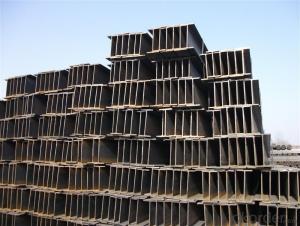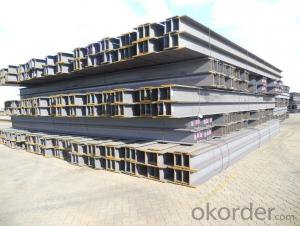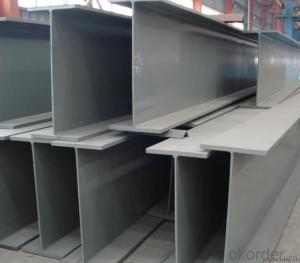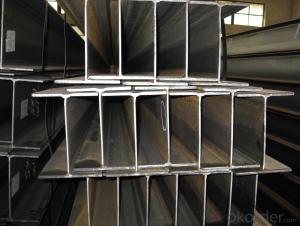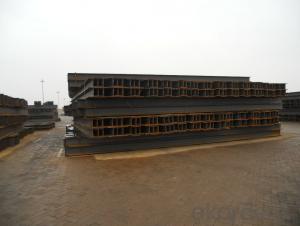Hot rolled steel H beams for sale
- Loading Port:
- Shanghai
- Payment Terms:
- TT OR LC
- Min Order Qty:
- 25 m.t.
- Supply Capability:
- 30000 m.t./month
OKorder Service Pledge
OKorder Financial Service
You Might Also Like
Specifications of Hot Rolled Structural Steel H Beam
1. Standard: GB700-88, Q235B2.
2. Grade: Q235, SS400 or Equivalent
3. Length: 6m,10m, 12m as following table
4. Invoicing on theoretical weight or actual weight as customer request
5.Payment: TT or L/C
6. Sizes:
SIZE(mm) | DIMENSION(kg/m) |
100*100 | 16.9 |
125*125 | 23.6 |
150*75 | 14 |
150*150 | 31.1 |
148*100 | 20.7 |
198*99 | 17.8 |
200*100 | 20.9 |
248*124 | 25.1 |
250*125 | 29 |
Usage & Applications of Hot Rolled Structural Steel H Beam
Commercial building structure ;Pre-engineered buildings; Machinery support structure; Prefabricated structure; Medium scale bridges; Ship-building structure. etc.
Packaging & Delivery of Hot Rolled Structural Steel H Beam
1. Packing: it is nude packed in bundles by steel wire rod
2. Bundle weight: not more than 3.5MT for bulk vessel; less than 3 MT for container load
3. Marks:
Color marking: There will be color marking on both end of the bundle for the cargo delivered by bulk vessel. That makes it easily to distinguish at the destination port.
Tag mark: there will be tag mark tied up on the bundles. The information usually including supplier logo and name, product name, made in China, shipping marks and other information request by the customer.
If loading by container the marking is not needed, but we will prepare it as customer request.
4. Transportation: the goods are delivered by truck from mill to loading port, the maximum quantity can be loaded is around 40MTs by each truck. If the order quantity cannot reach the full truck loaded, the transportation cost per ton will be little higher than full load.
5. Delivered by container or bulk vessel
Production flow of Hot Rolled Structural Steel H Beam
Material prepare (billet) —heat up—rough rolling—precision rolling—cooling—packing—storage and transportation
- Q:Can Steel H-Beams be used in elevated or suspended structures?
- Yes, Steel H-Beams can be used in elevated or suspended structures. Steel H-Beams are commonly used in construction due to their strength, stability, and durability. They are designed to carry heavy loads and provide structural support, making them suitable for various applications, including elevated or suspended structures. These beams can be used in the construction of bridges, mezzanines, platforms, walkways, and other similar structures where elevated or suspended support is required. The H-shape of the beam provides excellent load-bearing capacity and allows for even distribution of weight, ensuring the stability and safety of the structure. Additionally, Steel H-Beams can be customized to meet specific design requirements and can be easily interconnected or joined with other structural members to create a robust and reliable framework. Therefore, Steel H-Beams are an ideal choice for elevated or suspended structures that demand high strength and stability.
- Q:How do steel H-beams perform in vibration-prone environments?
- Steel H-beams have gained a reputation for their exceptional performance in environments prone to vibrations. The distinctive design of H-beams, characterized by their wide flanges and vertical web, grants them superior rigidity and strength, resulting in a high resistance to vibrations. This structural shape effectively distributes the load evenly, minimizing the impact of vibrations on the beam. The utilization of steel as the material for H-beams ensures remarkable durability and stability, making them especially suitable for environments where vibrations are prevalent. Steel possesses a high modulus of elasticity, enabling it to endure and absorb vibrations without experiencing significant deformation or damage. This property establishes steel H-beams as a dependable choice for structures exposed to dynamic loads, including bridges, high-rise buildings, and industrial facilities. Moreover, steel H-beams can be customized with additional measures to enhance their performance in vibration-prone environments. These measures encompass options such as thicker flanges, increased beam depth, or the inclusion of damping materials. By implementing these measures, the H-beams can further mitigate vibrations and minimize their impact on the overall structure. In conclusion, the inherent strength, rigidity, and durability of steel H-beams make them well-suited for environments susceptible to vibrations. Their distinctive design and properties empower them to endure vibrations without compromising the stability of the structure. When appropriately designed and executed, steel H-beams offer a reliable and efficient solution for structures that must excel in such challenging conditions.
- Q:Are steel H-beams suitable for supporting mezzanine storage systems?
- Indeed, steel H-beams are a fitting choice for supporting mezzanine storage systems. Given their robustness and durability, steel H-beams are widely utilized in construction and industrial settings. They offer outstanding support for heavy loads and are engineered to endure considerable weight and pressure. Mezzanine storage systems, which necessitate sturdy and dependable support structures, demand the utmost safety and stability. Steel H-beams fulfill these prerequisites and are adept at effectively supporting mezzanine storage systems.
- Q:What are the fire resistance ratings for steel H-beams?
- The fire resistance ratings for steel H-beams depend on various factors such as the dimensions of the beam, the type of fire protection applied, and the specific building codes and regulations in place. Generally, steel H-beams have inherent fire-resistant properties due to their high melting point and structural stability. However, to enhance their fire resistance, additional fireproofing materials such as intumescent coatings or fire-resistant insulations can be applied. These measures can significantly increase the fire resistance ratings of steel H-beams, allowing them to withstand fire exposure for extended periods, typically ranging from 30 minutes to several hours.
- Q:What's the difference between I-beam and H?
- I-beamI like the name suggests, is a funny site shaped steel flange on the inner surface of slope is generally 1:6, the flange and the thickness of thin, resulting in two main characteristics of I-beam section plane is huge, just to play strength characteristics in the application. Although there has been a thicker I-beam on the I-beam market, the structure of I-beam has decided its torsional performance.
- Q:How do Steel H-Beams compare to other structural beams, such as I-beams or wood beams?
- Construction widely utilizes Steel H-beams, also known as wide flange beams, due to their numerous advantages over other structural beams like I-beams or wood beams. To begin with, steel H-beams possess a higher strength-to-weight ratio in comparison to wood beams. This implies that they can support larger loads while being lighter, making them ideal for heavy-duty construction projects. On the contrary, wood beams have limited load-bearing capacity and may necessitate larger dimensions to achieve similar strength. Another benefit of steel H-beams is their design flexibility and versatility. These beams can be easily customized in terms of length, size, and shape, making them suitable for a wide range of construction applications. Additionally, steel H-beams can be joined together using welding or bolting techniques, allowing for the construction of intricate and stable structures. In terms of durability and resistance, steel H-beams outperform wood beams. They are immune to rot, decay, or insect damage, unlike wood, making them a more long-lasting option. Furthermore, steel H-beams are fire-resistant, making them a safer choice for construction in high-risk areas. Moreover, steel H-beams offer superior stability and structural integrity compared to I-beams. The design of H-beams, with their wider flanges and thinner web, facilitates better load distribution and reduces the risk of bending or buckling under heavy loads. This structural stability is particularly crucial in large-scale construction projects that necessitate dependable and strong support systems. Lastly, steel H-beams are more environmentally friendly than wood beams. Wood beams require the cutting down of trees, contributing to deforestation, whereas steel beams can be manufactured from recycled materials and are fully recyclable at the end of their life cycle. In conclusion, steel H-beams possess several advantages over other structural beams like I-beams or wood beams. They offer a higher strength-to-weight ratio, better durability, versatility in design, and superior stability. These factors make steel H-beams a preferred choice in many construction projects, particularly those requiring heavy loads and long-lasting structures.
- Q:Can steel H-beams be used in agricultural or farming structures?
- Yes, steel H-beams can be used in agricultural or farming structures. Steel H-beams are commonly used in construction due to their high strength-to-weight ratio, durability, and ability to withstand heavy loads. In agricultural or farming structures, such as barns, sheds, or storage buildings, steel H-beams can provide structural support and stability. They can be used for framing, roof trusses, or as columns and beams to create open spaces for storing equipment, livestock, or crops. Additionally, steel H-beams are resistant to pests, fire, and decay, making them a reliable choice for long-lasting agricultural structures.
- Q:Can steel H-beams be used in data center construction?
- Yes, steel H-beams can be used in data center construction. Steel H-beams are commonly used in construction projects due to their strength, durability, and versatility. They provide excellent load-bearing capabilities, making them suitable for supporting heavy equipment and structures in data centers. Additionally, steel H-beams offer a high degree of flexibility in design and can be easily customized to meet specific construction requirements. Their use ensures the stability and longevity of the data center, making them a popular choice in the construction industry.
- Q:Are steel H-beams resistant to impact or vibration?
- Steel H-beams are known for their excellent strength and durability, making them highly resistant to impact and vibration. The design of H-beams, with their wide flanges and thick web, allows them to distribute forces evenly and efficiently, minimizing the effects of impact and vibration. The inherent properties of steel, such as its high tensile strength and elasticity, contribute to its ability to withstand external forces. When subjected to impact, steel H-beams have the capacity to absorb and dissipate the energy generated by the impact, preventing any significant damage or deformation. This makes them suitable for applications where impact resistance is crucial, such as in construction, bridges, and high-rise buildings. Similarly, steel H-beams exhibit remarkable resistance to vibration. Their robust construction eliminates the risk of excessive deflection or oscillation when subjected to vibrational loads. This makes them ideal for structures that are exposed to various types of vibrations, such as machinery, heavy equipment, and seismic loads. However, it's important to note that the specific resistance to impact and vibration of steel H-beams can vary depending on factors such as the quality of the steel used, the design of the beam, and the magnitude and frequency of the forces applied. In certain situations, additional measures such as dampers or vibration isolation systems may be necessary to further enhance their performance. Overall, steel H-beams are well-regarded for their exceptional resistance to impact and vibration, making them a reliable choice for a wide range of structural applications.
- Q:How do steel H-beams compare to other types of structural beams?
- Steel H-beams are commonly used in construction and engineering projects due to their numerous advantages compared to other types of structural beams. One significant advantage of steel H-beams is their high strength-to-weight ratio. Due to their unique shape, H-beams are able to distribute weight evenly along their length, making them exceptionally strong and capable of supporting heavy loads. This characteristic allows for the construction of longer spans and taller structures, without the need for additional support columns or beams. Another advantage of steel H-beams is their versatility. They can be easily fabricated and customized to fit specific project requirements. H-beams can be cut, welded, and drilled, allowing for greater flexibility in design and construction. This versatility makes them suitable for a wide range of applications, from building construction to bridge and infrastructure projects. In addition, steel H-beams have excellent resistance to bending and twisting forces. This is particularly beneficial in earthquake-prone areas, as the beams can absorb and distribute seismic forces, ensuring the structural integrity of buildings and minimizing damage. Furthermore, steel H-beams have a long lifespan and require minimal maintenance. They are highly durable, resistant to corrosion, and unaffected by environmental conditions such as humidity or temperature changes. This durability ensures the longevity of structures and reduces the need for costly repairs or replacements. Lastly, steel H-beams are cost-effective. Although initially more expensive than some other types of structural beams, their long lifespan and low maintenance requirements ultimately result in lower overall costs over time. Additionally, their high strength-to-weight ratio allows for lighter foundations and reduced material usage, further contributing to cost savings. In summary, steel H-beams offer numerous advantages compared to other types of structural beams. Their high strength-to-weight ratio, versatility, resistance to bending and twisting, durability, and cost-effectiveness make them a popular choice in construction and engineering projects.
1. Manufacturer Overview |
|
|---|---|
| Location | |
| Year Established | |
| Annual Output Value | |
| Main Markets | |
| Company Certifications | |
2. Manufacturer Certificates |
|
|---|---|
| a) Certification Name | |
| Range | |
| Reference | |
| Validity Period | |
3. Manufacturer Capability |
|
|---|---|
| a)Trade Capacity | |
| Nearest Port | |
| Export Percentage | |
| No.of Employees in Trade Department | |
| Language Spoken: | |
| b)Factory Information | |
| Factory Size: | |
| No. of Production Lines | |
| Contract Manufacturing | |
| Product Price Range | |
Send your message to us
Hot rolled steel H beams for sale
- Loading Port:
- Shanghai
- Payment Terms:
- TT OR LC
- Min Order Qty:
- 25 m.t.
- Supply Capability:
- 30000 m.t./month
OKorder Service Pledge
OKorder Financial Service
Similar products
New products
Hot products
Hot Searches
Related keywords
